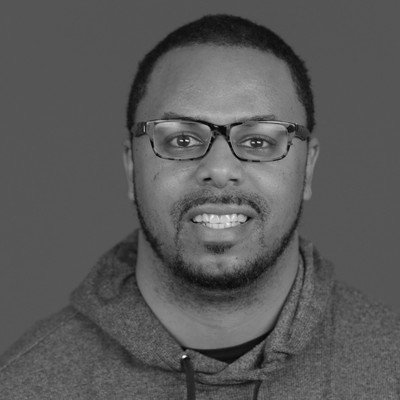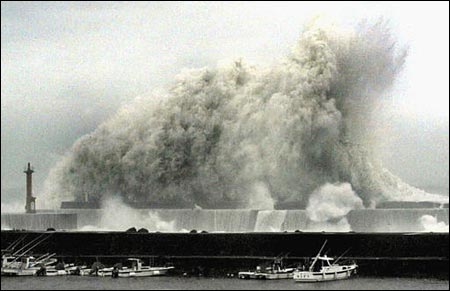Seattle, WA. (5-30-20). — GEORGE FLOYD PROTEST IN SEATTLE: Rally turns violent. National Guard called in, weapons banned citywide, police rifles stolen. 5:00pm Curfew Imposed.
by Casey Martin, Eilis O’Neill, Gil Aegerter, Megan Farmer– (KUOW)
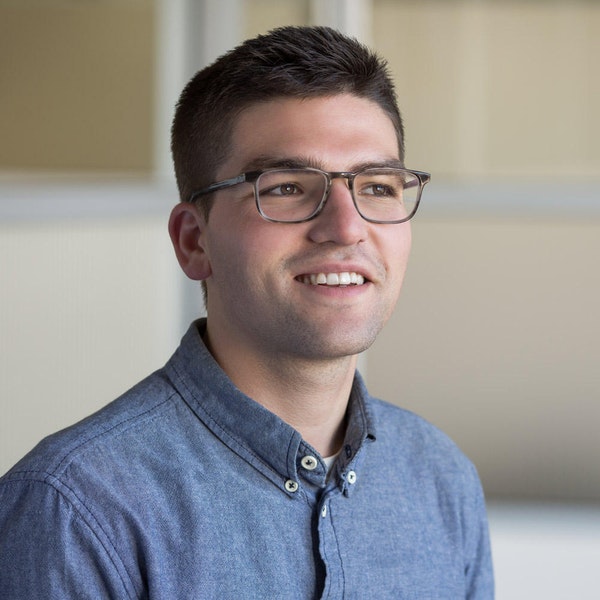


Demonstrators moved through downtown Seattle on Saturday evening to protest the police killing of George Floyd, a black man in Minneapolis.
Over the afternoon and into the evening, the demonstration gave way to incidents of violence and destruction.



What to know:
- A peaceful march protesting police violence and killings of black people in America appears to have been taken over by violent groups in downtown Seattle.
- Two AR-15 rifles were stolen from police cars (both have been recovered); several cop cars were set on fire; several community members and police officers have been injured; no serious injuries have been reported.
- Mayor Jenny Durkan implemented a citywide curfew for 5 p.m. on Saturday and Sunday, May 30 and May 31. Residents of downtown Seattle have been instructed to shelter in place.
- Gov. Jay Inslee has activated 200 unarmed members of the state National Guard. Those guard members will be assisting with infrastructure protection and traffic for the next seven days.
- City officials report that the demonstrations during the day were peaceful, but they turned violent as a group began to throw Molotov cocktails into buildings and cars. They also shot fireworks into the crowd of demonstrators and at police. Firefighters were prevented from getting to the fires and were eventually escorted to the blazes by police.

Live updates on the situation in downtown Seattle
A timeline update, created by KUOW graphics designer Teodora Popescu:


Update 10:20 p.m. The crowd appears to have diminished downtown. Some groups remain. Police are using flash bangs around 6th Avenue and Pine Street.

Update 8:25 p.m. Law enforcement agencies other than Seattle police responded to the violence in downtown Saturday. Washington State Patrol troopers have been spotted along the street, as well as officers from Tukwila, and deputies with the King County Sheriff’s Office.



Small groups of protesters still being broken up. Washington State Patrol and King County Sheriff assisting Seattle Police.188:38 PM – May 30, 2020 · Westlake ParkTwitter Ads info and privacy15 people are talking about this

Washington State Patrol is out on corners near Convention Center.
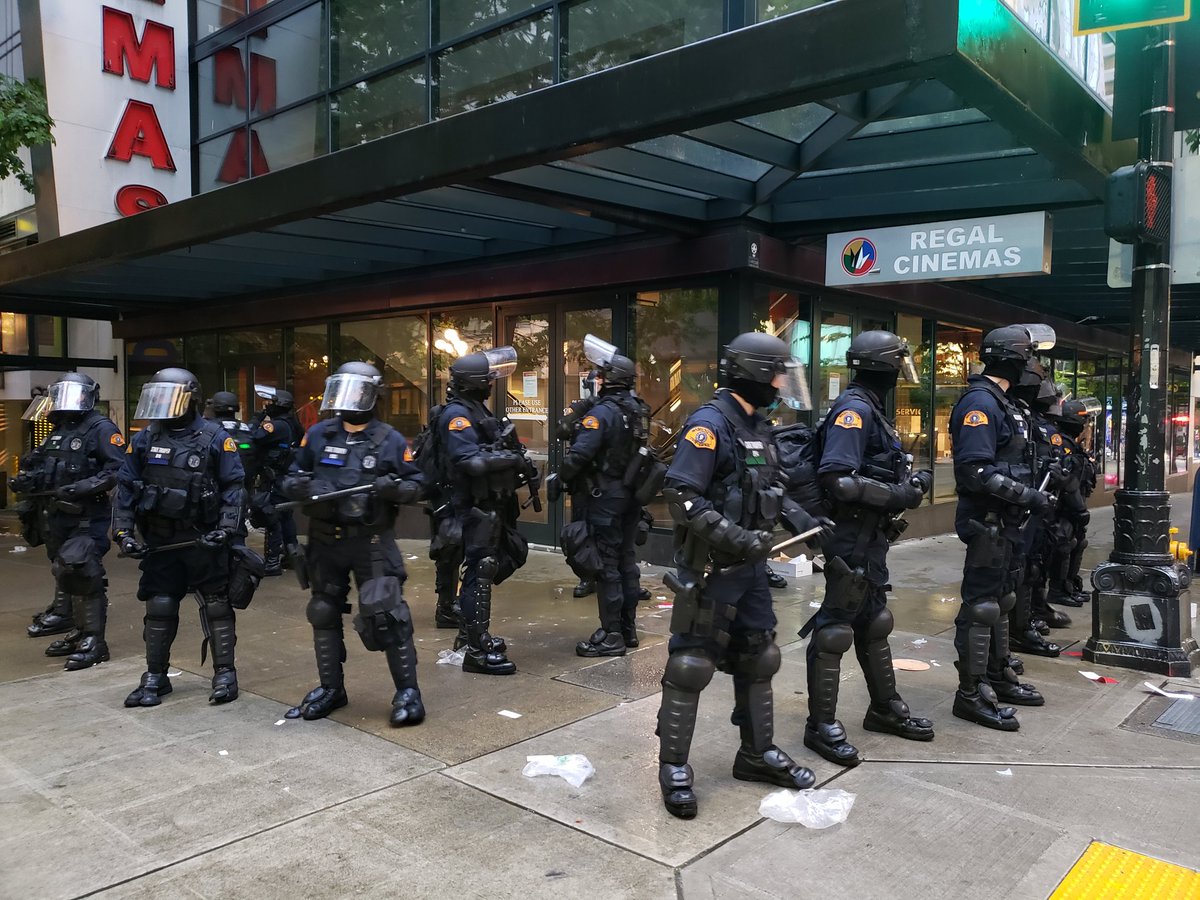
Update 8:10 p.m. KUOW Reporter Casey Martin reports that some shops in downtown Seattle have been broken into.



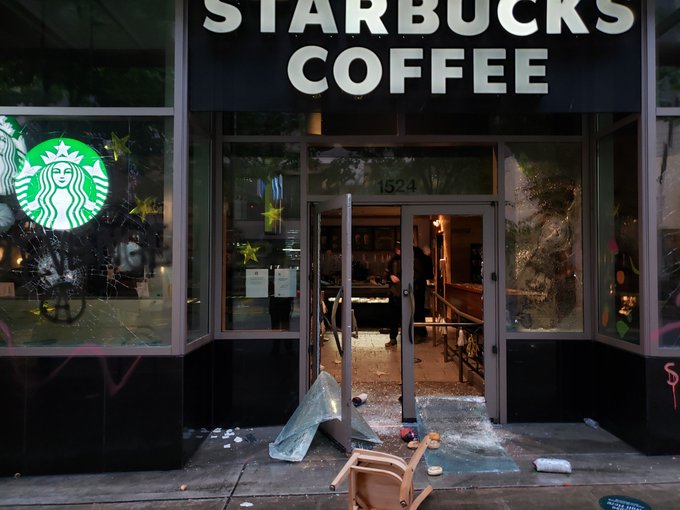
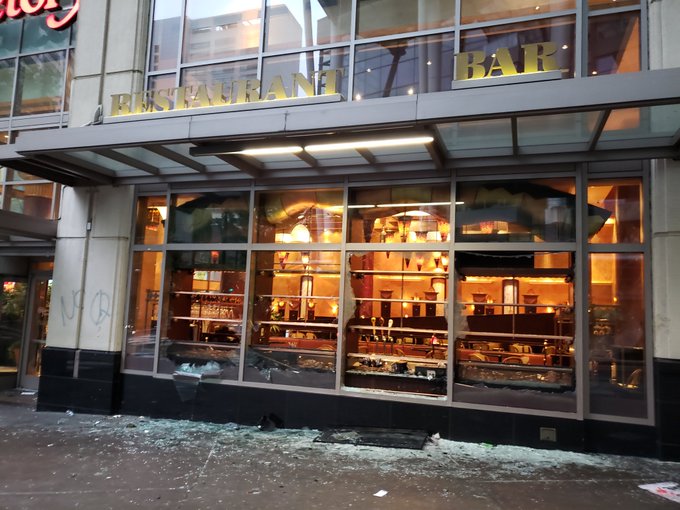
168:07 PM – May 30, 2020 · The Cheesecake FactoryTwitter Ads info and privacySee Casey Martin’s other Tweets Update 8:05 p.m.


If you are still out, I ask you to stay home and abide by the curfew. You can find more questions about the curfew here: https://durkan.seattle.gov/2020/05/frequently-asked-questions-about-the-curfew-order/ …Frequently Asked Questions About the Civil Emergency Curfew Order – Office of the MayorToday, Mayor Jenny A. Durkan issued a civil emergency that includes a citywide curfew from Saturday, 5:00 p.m. to Sunday 5:00 a.m. and from Sunday 5:00 p.m. to Monday 5:00 a.m. The FAQ below will…durkan.seattle.gov

I hope that we treat each other with the kindness and compassion that we all deserve during this unprecedented and trying moment in our history.
I think we will see the message of destruction is not as strong as the message of hope, love, and peace.658:05 PM – May 30, 2020Twitter Ads info and privacy138 people are talking about this
Update 7:45 p.m. The Seattle Police Department reports that all rifles stolen from its patrol vehicles earlier Saturday have now been recovered.


Earlier today two rifles were stolen from SPD patrol cars that were set on fire. We have since recovered both rifles. We currently have no reports that the rifles were fired while they were out of our possession.1,2657:45 PM – May 30, 2020Twitter Ads info and privacy487 people are talking about this
Update 7:43 p.m. At a Saturday evening briefing, Mayor Durkan responded to a question regarding police body cameras and why they were turned off during the protests.

“Seattle has a long standing law and culture of not believing that police surveillance is appropriate. And before and police inappropriately gathering intelligence on lawful and peaceful demonstrations is prohibited. And so police department, we do not turn the body cameras on unless we think there’s going to be criminal activity or they have to take actions as a police officer, our, our policies are written and were well thought out they were developed with the assistance of a number of people, because we do not want people to believe that police are there to surveil and record lawful protests. And so the body cameras were not on, not to hide what was happening but to respect the right of the protesters.”
Update 7:25 p.m. The Seattle Fire Department reports that there remains several fires throughout the downtown area.



Multiple vehicles currently on fire at 4th and Pike St. Avoid the area. Firefighters arriving on scene and will work towards extinguishment as it’s safe to do so.1157:25 PM – May 30, 2020 · Seattle, WATwitter Ads info and privacy74 people are talking about this



Our firefighters are out there working incredibly hard to keep you safe. There have been many vehicle fires across the downtown core and injuries to both police officers and members of the public. Read remarks from Chief Scoggins on Fireline: https://fireline.seattle.gov/2020/05/30/remarks-from-fire-chief-harold-scoggins-in-response-to-downtown-protests/ …1577:12 PM – May 30, 2020Twitter Ads info and privacy43 people are talking about this
Update 7:15 p.m. At a briefing earlier Saturday, Seattle Fire Chief Harold Scoggins said that firefighters were not initially able to reach fires in the downtown area. They were eventually escorted to blazes by police.
Scoggins stressed that he supports the right to protest and demonstrate.
“This is not the way to do it, by causing unnecessary chaos and danger to those who are protesting and those in the community,” he said. “This situation has escalated quickly and has become very dangerous.”

Update 7 p.m. At her briefing earlier Saturday evening, Mayor Durkan said that the city will be investigating reports of police use-of-force, and also looking over video posted on social media showing police interaction with demonstrators.
The city will also look into reports that some officers had covered their badge numbers.
Update 6:30 p.m. The Downtown Seattle Association released a statement saying: “A peaceful protest in Westlake Park this afternoon was hijacked by people a block away who were intent on destruction. Messages of peace and pleas for change were overshadowed by burning cars, black smoke and broken windows….
It’s shameful that some individuals have exploited the tragic killing of George Floyd by resorting to violence and destruction, putting the lives of others at risk, including first responders and those who came downtown to peacefully gather. These are cowardly acts that have no place in our city.”
Update 6:20 p.m. At a press conference this evening, Seattle Mayor Jenny Durkan said she issued a civil emergency over the demonstrations and “escalated violence and destruction” in downtown Seattle.
“I understand the immense rage and grief and sense of betrayal felt by so many in our community and communities across this country,” Durkan said.
“However, the escalated incidents of destruction and violence do not honor Mr. Floyd,” she said. “His own family has spoken against such violence and has urged everyone to demonstrate peacefully. The criminal acts that took place during today’s demonstrations cannot and will not be allowed to continue. They jeopardize the health and safety of all those involved from those demonstrating peacefully, to our first responders, to civilians who happen to be in the area.”
George Floyd was killed by a police officer in Minneapolis who has since been charged with third-degree murder, and who is in custody.
Durkan said it was a difficult decision to make, approving the curfew and weapons ban, given that people who live in Seattle enjoy the right to come together.
“It is clear that there was a large number of people who came to protest peacefully. That organizers like Andre Taylor and others were able to speak. The crowd was able to march, and they maintained themselves very peacefully.
“But then we had many thousands of people flow into downtown who obviously were coming, primarily for destruction and very rapidly, the amount of destruction escalated and the situation deteriorated quickly.”
Update 5:50 p.m.

Downtown Seattle smells strongly of tear gas. Sirens ring constantly in the distance. Protesters added a pallet & debris to this car fire. The 5 o’clock downtown curfew has come and gone. #GeorgeFloydprotest #seattleprotest
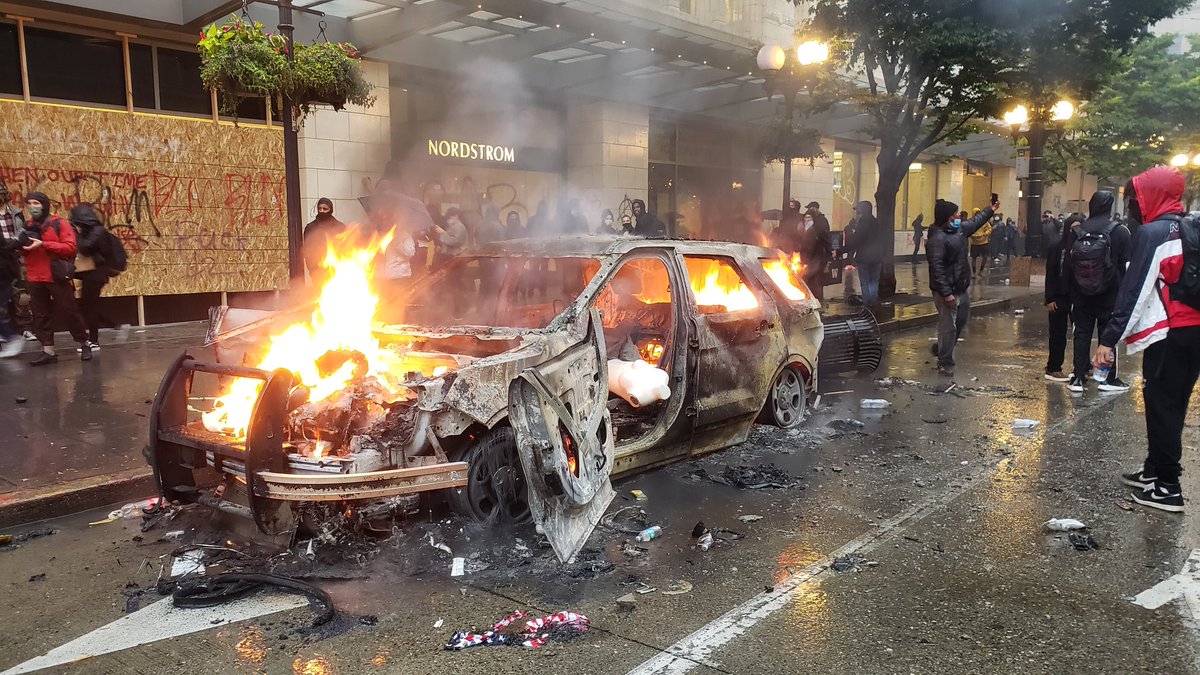

There is a tense standoff now between protesters and police on Pike in front of Nordstrom’s. More flash bangs, stores broken into, and a lot more riot police just arrived with batons. #seattleprotest #GeorgeFloydprotest345:50 PM – May 30, 2020Twitter Ads info and privacy24 people are talking about this
Update 5:50 p.m. Two AR-15 rifles were stolen from Seattle police vehicles. One remains outstanding; police recovered the other.
This tweeted video of a live KOMO TV feed shows what is likely the recovery of one of those rifles. Brandi Kruse of Q13 FOX News explained that this man is her team’s security guard and “took the AR 15 from the rioter and disabled it. We called 911 and waited to hand it over.”

White guy in #seattle protest open carrying, what appears to be an AR15, has his weapon taken away by an undercover police officer at gun point. 18.9K4:43 PM – May 30, 2020 · Seattle, WATwitter Ads info and privacy9,648 people are talking about this
Meanwhile, weapons have been banned in the city of Seattle, per a civil emergency signed by Mayor Jenny Durkan. Weapons, per the order, include guns, rocks, pipes, clubs and flares. The emergency order is citywide, not just confined to downtown.
Several Seattle Police vehicles have been set on fire, the mayor’s memo says.
Multiple people have been injured in the protest, including community members and police officers, according to the mayor’s memo.
Durkan’s memo on Saturday night included more information about the unarmed National Guard personnel called in by Gov. Jay Inslee at the city’s request: They will be assisting for the next seven days.
Demonstrators threw bottles and lit fireworks into crowds, the memo says.
The Seattle Fire Department has limited / completely restricted access to buildings that are on fire.
5:23 p.m. Washington State Governor Jay Inslee announced that the National Guard has been activated and sent to Seattle to assist with the situation there.

At the request of @CityofSeattle I have activated 200 members of the @WANationalGuard to help protect against property damage and manage crowds and traffic in downtown Seattle. They will be unarmed and work under the city’s leadership. https://www.governor.wa.gov/news-media/inslee-activates-national-guard-request-city-seattle …Inslee activates National Guard at request of City of SeattleGov. Jay Inslee today activated up to 200 members of the Washington National Guard in response to a request from the City of Seattle to help protect against property damage and manage crowds andgovernor.wa.gov2,2515:23 PM – May 30, 2020Twitter Ads info and privacy2,554 people are talking about this
Update 5:20 p.m. Mayor Jenny Durkan declared a curfew in Seattle beginning at 5 p.m. Saturday after an afternoon of protests over the police killing of George Floyd in Minneapolis.

I will soon be signing an emergency order and the @CityofSeattle will be imposing a 5 pm curfew soon. Crowds need to disburse from downtown immediately.1,7604:46 PM – May 30, 2020Twitter Ads info and privacy2,740 people are talking about this
She made the announcement at 4:46 p.m. on Twitter — 14 minutes for hundreds, perhaps thousands of people to get word, and then disperse.
And then at 5:18 p.m., officials announced that the state National Guard had been activated. Guard members would be unarmed.
Mayor Durkan requested the Guard to assist with Seattle Police, Gov. Jay Inslee said in a statement.
“The National Guard is on stand by to assist the Seattle Police Department as requested by Mayor Durkan,” Inslee said. “They will be unarmed and assist with infrastructure protection and crowd movement. They will only be utilized if absolutely necessary and we appreciate their efforts to help in this important work.”
Durkan said the curfew is in effect until 5 a.m. tomorrow and then will be in effect again Sunday at 5 p.m.
She said it’s intended to prevent any violence or property damage … and to reduce the risk of spreading the coronavirus.
Residents are advised to remain in their residences “to the extent possible” and to refrain from traveling in and through Seattle.
The mayor’s office said the curfew is intended to “prevent violence and widespread property damage, and to prevent the further community spread of COVID-19 through continued gathering.”
Officials said the curfew does not apply to people who need to commute to work during these hours, homeless people, people in a medical emergency or people in a dangerous situation, first responders, health care workers, and the news media. They said it also does not require businesses to close while it is in effect, and it will not alter public transit schedules.
Update 5:18 p.m.

Protesters run from rubber bullets and tear gas as cars downtown wait for the light to change.

Downtown Seattle smells strongly of tear gas. Sirens ring constantly in the distance. Protesters added a pallet & debris to this car fire. The 5 o’clock downtown curfew has come and gone. #GeorgeFloydprotest #seattleprotest

475:18 PM – May 30, 2020 · Nordstrom Corporate HeadquartersTwitter Ads info and privacy26 people are talking about this
Update 4:47 p.m.

Just south of me: large cloud of tear gas. To the north downtown: black smoke from a reported car fire. #seattleprotest #GeorgeFloydprotest 1




Update 4:15 p.m.: Hundreds of people have walked onto Interstate 5 in downtown Seattle during protests over the death of George Floyd.
They entered on the Spring Street entrance and were southbound. The Washington State Patrol said southbound I-5 was closed.
Outside the Nordstrom downtown, a burning police car sent up clouds of dense smoke.

Update, 3:30 p.m.: Protesters clashed with police in downtown Seattle on Saturday amid nationwide unrest over the death of Floyd in Minneapolis.
Police used pepper spray, and explosions were heard near Westlake Park as thousands of people converged on the area. It was not clear if anyone had been arrested.

Multiple flash bangs going off near Westlake in downtown Seattle. #GeorgeFloydprotest #seattleprotest992:41 PM – May 30, 2020 · Westlake
At least two rallies had been planned for downtown Seattle on Saturday, and initially they were peaceful as people rallied outside police headquarters and marched to Westlake.

Update, 3 p.m.: Seattle police say they’ll review an incident during protests overnight Friday in which officers used force.
A video of the incident that circulated on social media appeared to show officers punch a person as they arrested him.
In a statement Chief Carmen Best said:
“During the demonstrations last night, amidst property destruction and confrontations with officers, there were several arrests. In one arrest, which has received media attention, officers used force. Under SPD’s policies relating to crowd management and review of force, any force that is used during the course of last night’s event will undergo a high level of scrutiny and review by the chain of command, SPD’s Force Review Board, the Office of Police Accountability, and the Office of the Inspector General.”
The incident came amid several arrests overnight in downtown Seattle over the death in Minneapolis of George Floyd at the hands of police.
Best also addressed reports that officers were ordered to turn off video cameras worn on their uniforms. She said it was untrue.
“Last night, as we do during all First Amendment events, officers only activated the cameras if they believed they were going to witness criminal behavior (SPD Policy 16.090).”
She said under city ordinance, officers are not supposed to record people lawfully engaged in protest.
Meanwhile, Gov. Jay Inslee urged protesters to demonstrate peacefully in honoring Floyd.
“Everyone has the freedom – and the right – to demonstrate and speak their mind,” he said. “However, violence and destruction have no place in Washington state or our country.”
Update 2:41 p.m.

Multiple flash bangs going off near Westlake in downtown Seattle. #GeorgeFloydprotest #seattleprotest992:41 PM – May 30, 2020 · Westlake ParkTwitter Ads info and privacy79 people are talking about this
Update, 1:35 p.m.: A crowd gathered Saturday in downtown Seattle, protesting the death of George Floyd and those of other African Americans at the hands of police.
Seattle police officers stood by as hundreds of people listened to speakers in the rain outside Police Department headquarters at 5th Avenue and Cherry.
Many in the crowd wore masks as protection against the coronavirus, though it appeared social distancing was difficult.
The crowd then began walking toward Westlake Park, where another protest was planned.
ORIGINAL POST:
Unrest in Seattle over the death of George Floyd led to damage downtown and arrests overnight Friday. More protests are planned Saturday.
People marched downtown Friday evening after a rally in the International District. TV news video showed people breaking windows along Fifth Avenue and clashing with police.
The Seattle Police Department said seven people were arrested.
There have been protests in other cities across the U.S. over the case of Floyd, the African American man who died in Minneapolis after a white police officer kneeled on his neck. There was widespread damage in downtown Portland overnight, according to news reports.
Several protests were planned for Saturday in Seattle.
André Taylor, the founder of Not This Time, organized one of those, set for 3 p.m. at Westlake Center.
Update, 3 p.m.: Seattle police say they’ll review an incident during protests overnight Friday in which officers used force.
A video of the incident that circulated on social media appeared to show officers punch a person as they arrested him.
In a statement Chief Carmen Best said:
“During the demonstrations last night, amidst property destruction and confrontations with officers, there were several arrests. In one arrest, which has received media attention, officers used force. Under SPD’s policies relating to crowd management and review of force, any force that is used during the course of last night’s event will undergo a high level of scrutiny and review by the chain of command, SPD’s Force Review Board, the Office of Police Accountability, and the Office of the Inspector General.”
The incident came amid several arrests overnight in downtown Seattle over the death in Minneapolis of George Floyd at the hands of police.
Best also addressed reports that officers were ordered to turn off video cameras worn on their uniforms. She said it was untrue.
“Last night, as we do during all First Amendment events, officers only activated the cameras if they believed they were going to witness criminal behavior (SPD Policy 16.090).”
She said under city ordinance, officers are not supposed to record people lawfully engaged in protest.
Meanwhile, Gov. Jay Inslee urged protesters to demonstrate peacefully in honoring Floyd.
“Everyone has the freedom – and the right – to demonstrate and speak their mind,” he said. “However, violence and destruction have no place in Washington state or our country.”
Update, 1:35 p.m.: A crowd gathered Saturday in downtown Seattle, protesting the death of George Floyd and those of other African Americans at the hands of police.
Seattle police officers stood by as hundreds of people listened to speakers in the rain outside Police Department headquarters at 5th Avenue and Cherry.
Many in the crowd wore masks as protection against the coronavirus, though it appeared social distancing was difficult.
The crowd then began walking toward Westlake Park, where another protest was planned.
ORIGINAL POST:
Unrest in Seattle over the death of George Floyd led to damage downtown and arrests overnight Friday. More protests are planned Saturday.
People marched downtown Friday evening after a rally in the International District. TV news video showed people breaking windows along Fifth Avenue and clashing with police.
The Seattle Police Department said seven people were arrested.
There have been protests in other cities across the U.S. over the case of Floyd, the African American man who died in Minneapolis after a white police officer kneeled on his neck. There was widespread damage in downtown Portland overnight, according to news reports.
Several protests were planned for Saturday in Seattle.
André Taylor, the founder of Not This Time, organized one of those, set for 3 p.m. at Westlake Center.
He said it was important for people to be able to express their anger over Floyd’s death and the police action that led to that.
“It was disgusting the cavalier attitude the officer had with his hands in his pockets,” Taylor said, referring to the police officer who kneeled on Floyd’s neck.
“It was like he was saying, ‘Eff the cameras. I’m going to show you as a white police officer what I can do to an unarmed black man and there will be no recourse.’ What’s the next step? Well, we lead the rest of the country: When we see incidents like this in our cities, here in Washington state, that we make sure that people are convicted for unjustified homicide.”
After Floyd’s death on Monday, the officer, Derek Chauvin, was fired then later charged with third-degree murder. A criminal complaint against Chauvin says he kneeled on Floyd’s neck for 8 minutes, 46 seconds — even after Floyd apparently ceased to breathe.
Organizers of the afternoon protest at Westlake are being asked to use social distancing and masks to avoid spreading the coronavirus.
Other groups have organized two other protests: one Saturday morning at Nathan Hale High School, and one at noon Saturday in downtown Seattle.
In a statement to her officers on Friday, SPD Chief Carmen Best called video of the Floyd incident “disappointing, and infuriating.” She said it was troubling that officers stood by while Floyd called for help.
“As a police officer, you have a sworn duty to uphold the law and do what is right. We prioritize the sanctity of life in every situation,” Best said.
“If you see a co-worker doing something that is unsafe, out of policy, unacceptable, or illegal, you need to act. This goes beyond reporting. If someone’s life is unnecessarily in danger, it is your responsibility to intervene.”
“We each have a right to go home at the end of the day, but we also have a responsibility to ensure that others enjoy that same right.”


